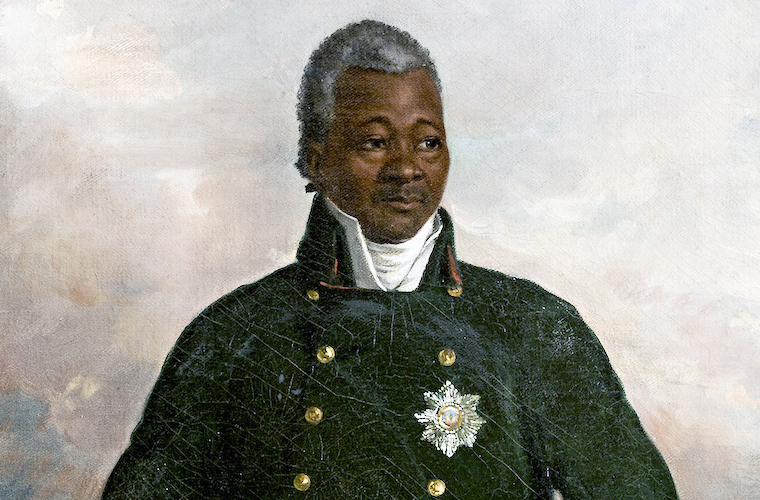Re-Engineering Hayti: Leadership, Legacy, and Lessons from the Monarchical Rule of King Henri Christophe
By: Raphël Biassou Hérissé, PhD
January 4, 2025

Henri Christophe (1767–1820), a central figure in Hayti’s early history, was a leader whose reign as King of Hayti (1811–1820) left a complex legacy. His rule as a monarch offers valuable insights into leadership, governance, and nation-building during one of the most tumultuous periods in Haytian history. As Hayti’s first and only king, Christophe’s reign represented an ambitious experiment in centralized authority and socio-economic reform following the Haytian Revolution. Christophe rose from enslavement to military general, statesman, and eventually monarch, playing a pivotal role in shaping Hayti’s governance and national identity. His rule was marked by remarkable achievements in infrastructure and education, tempered by authoritarian governance and economic challenges.
Historical Context: The Fragmented Nation
After Hayti gained independence in 1804, its leadership faced immense challenges. From external sources, the French continued to attack the country in failed attempts to reclaim the colony. At the same time, the United States of America and its allies imposed a blockade on the new nation preventing the continuation of the lucrative sugar, sisal, and indigo trade. Christopher faced internal challenges in unifying a nation devastated by colonial exploitation and war. Following the assassination of Emperor Jean-Jacques Dessalines in 1806, Hayti split into two political entities:
1. The northern Kingdom of Hayti, ruled by Henri Christophe.
2. The southern Republic of Hayti, governed by Alexandre Pétion.
Christophe established himself as king in the north, advocating centralized governance and economic development, while Pétion promoted republican ideals of liberty, equality, and fraternity. The fundamental elements in this construct were never fully realized because the equality was never attained and the divisions ran deep throughout the new nation.
Henri Christophe’s Vision for the Kingdom of Hayti
The Establishment of Monarchy
In 1811, Christophe declared himself King Henri I of Hayti, modeling his monarchy on European royal traditions. He established an elaborate court system with nobility titles and adopted regal ceremonies to legitimize his authority. While some viewed his monarchy as an attempt to consolidate power, Christophe believed a centralized, hierarchical system was essential for national unity and progress.
Economic Reforms
Christophe’s economic policies aimed to rebuild Hayti’s economy through agricultural production, particularly sugar and coffee. He implemented a labor system reminiscent of plantation models, requiring formerly enslaved individuals to work on state-controlled estates. Though effective in reviving agricultural production, this system was deeply unpopular and seen by many as a return to forced labor. Despite its controversies, Christophe’s policies generated revenue that funded public projects and infrastructure development.
Infrastructure and Architecture
Christophe’s reign is best remembered for its ambitious architectural projects, symbolizing Hayti’s resilience and independence:
• The Citadelle Laferrière: A massive fortress in northern Hayti, built to defend against potential French invasions. The Citadelle remains one of the most iconic symbols of Haytian sovereignty and is now a UNESCO World Heritage Site.
• Sans-Souci Palace: Christophe’s royal residence, symbolizing his vision of a modern, sophisticated nation. Its design is a blend of European styles with Haytian elements, demonstrating his aspiration to place Hayti on par with global powers.
Educational Reforms
Recognizing education’s transformative power, Christophe established schools and invited foreign educators to train Haytian teachers. He sought to create an educated elite capable of advancing Haytian society. His educational reforms reflected his long-term vision for national development, even as they favored the upper class over broader accessibility. Such practices were a major departure from the equality ideals touted in the nation’s credo. Education was viewed as a great equalizer for the nation’s citizens and the access was intended to transcend the men and women throughout the kingdom.
Governance and Challenges
Authoritarian Rule
Christophe’s governance style was deeply authoritarian. He ruled with an iron fist, suppressing dissent and centralizing power. His strict enforcement of labor policies and heavy taxation alienated large portions of the population, leading to widespread resentment. While his policies achieved some economic and infrastructural successes, they lacked popular support and were implemented at great human cost. Social Divisions Christophe’s reign exacerbated divisions between Hayti’s Black majority and mixed-race elites, who largely supported Pétion’s southern republic. These divisions hindered efforts to unify the nation and perpetuated the factionalism that plagued Hayti’s early years of independence.
External Pressures
Hayti under Christophe faced ongoing threats from France, which refused to recognize Hayti’s independence and demanded reparations for lost colonial property. Christophe’s defensive measures, including the Citadelle, reflected his determination to protect Hayti’s sovereignty, though the strain of maintaining such defenses burdened the economy.
The Fall of Christophe’s Monarchy
By 1820, widespread dissatisfaction with Christophe’s policies and governance style had reached a breaking point. His declining health and inability to quell rebellions among his subjects and military ultimately led to his downfall. On October 8, 1820, facing insurrection, Christophe took his own life rather than be captured. Following his death, the northern kingdom was absorbed into the southern republic, ending the monarchy he had built.
Legacy
Architect of Resilience
Henri Christophe’s contributions to Haytian architecture and defense, particularly the Citadelle and Sans-Souci Palace, remain symbols of Hayti’s determination to safeguard its sovereignty. These achievements reflect his vision of a strong, independent Hayti capable of standing against global powers.
Complex Leadership
Christophe’s reign offers a complex portrait of leadership. His authoritarian style alienated many, yet his commitment to national development and sovereignty demonstrated visionary qualities. The tension between his achievements and his failures underscores the challenges of governing a young, divided nation.
Lessons for Modern Hayti
1. Balancing Authority with Inclusion
Christophe’s failure to build consensus and address popular grievances highlights the importance of inclusive governance. Modern Haytian leaders must prioritize dialogue and
representation to avoid repeating the divisive politics of the past.
2. Investing in Education and Infrastructure
Christophe’s focus on education and infrastructure remains relevant. Sustainable development requires investment in human capital and national projects that inspire pride and progress.
3. Protecting Sovereignty
Christophe’s unwavering commitment to Haytian sovereignty reminds us of the importance of safeguarding independence while navigating global pressures.
4. Addressing Social Divisions
Christophe’s policies and deep social division continue to challenge Hayti today. Bridging these divides requires policies that promote equity and reconciliation.
Conclusion
King Henri Christophe’s rule as a monarch was marked by extraordinary ambition and vision, tempered by authoritarianism and societal challenges. His reign offers valuable lessons for navigating Hayti’s current socio-political crisis. By examining Christophe’s successes and failures, modern Haytian leaders can draw inspiration from his commitment to sovereignty, resilience, and development while avoiding the pitfalls of exclusionary governance. A reimagined Hayti, rooted in its revolutionary ideals and informed by its history, can emerge stronger and more unified in the 21st century. Through critical engagement with Christophe’s legacy, Hayti can honor its past while building a future of justice, inclusion, and progress.
Copyright and License Information
We or our licensors own and control all of the copyright and other intellectual property rights in the website and the data, information, and other resources displayed by or accessible within the website.
4.1 Creative Commons
The content on this website is available under a Creative commons – Noncommercial License, unless specified otherwise.
- For more information, please visit our Terms and Service page.
Author Information
By: Raphël Biassou Hérissé, PhD
